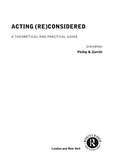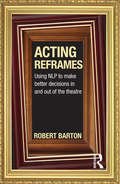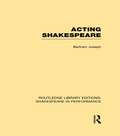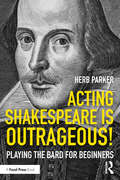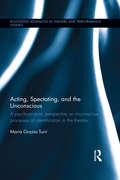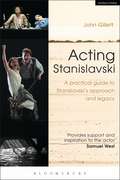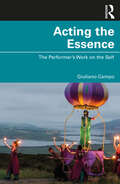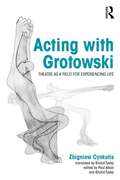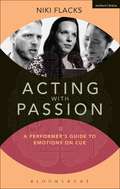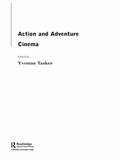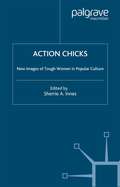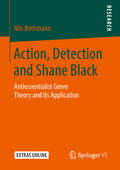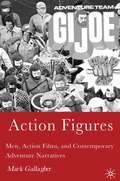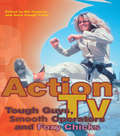- Table View
- List View
Acting (Re)Considered: A Theoretical and Practical Guide
by Phillip B. ZarrilliActing (Re)Considered is an exceptionally wide-ranging collection of theories on acting, ideas about body and training, and statements about the actor in performance. This second edition includes five new essays and has been fully revised and updated, with discussions by or about major figures who have shaped theories and practices of acting and performance from the late nineteenth century to the present.The essays - by directors, historians, actor trainers and actors - bridge the gap between theories and practices of acting, and between East and West. No other book provides such a wealth of primary and secondary sources, bibliographic material, and diversity of approaches. It includes discussions of such key topics as:* how we think and talk about acting* acting and emotion* the actor's psychophysical process* the body and training* the actor in performance* non-Western and cross-cultural paradigms of the body, training and acting.Acting (Re)Considered is vital reading for all those interested in performance.
Acting (Re)Considered: A Theoretical and Practical Guide
by Phillip B. ZarrilliActing (Re)Considered is an exceptionally wide-ranging collection of theories on acting, ideas about body and training, and statements about the actor in performance. This second edition includes five new essays and has been fully revised and updated, with discussions by or about major figures who have shaped theories and practices of acting and performance from the late nineteenth century to the present.The essays - by directors, historians, actor trainers and actors - bridge the gap between theories and practices of acting, and between East and West. No other book provides such a wealth of primary and secondary sources, bibliographic material, and diversity of approaches. It includes discussions of such key topics as:* how we think and talk about acting* acting and emotion* the actor's psychophysical process* the body and training* the actor in performance* non-Western and cross-cultural paradigms of the body, training and acting.Acting (Re)Considered is vital reading for all those interested in performance.
Acting Reframes: Using NLP to Make Better Decisions In and Out of the Theatre
by Robert BartonActing Reframes presents theatre and film practitioners with a methodology for using Neuro-Linguistic Programming (NLP) as a tool to aid their practice. Author Robert Barton uses the NLP approach to illustrate a range of innovative methods to help actors and directors, including: • reducing performance anxiety • enabling clearer communication • intensifying character analysis • stimulating imaginative rehearsal choices. The author also shows how NLP can used alongside other basic training systems to improve approaches to rehearsal and performance. The book shows the use of NLP to the reader in a playful, creative and easily accessible style that is structured to enable solo study as well as group work. The text offers a range of engaging exercises and extensive analysis of language patterns used in performance. It is a source for enhancing communication between all theatre practitioners in training, productions, and daily life outside the theatre. Acting Reframes gives actors a richly rewarding approach to help them develop all aspects of their craft.
Acting Reframes: Using NLP to Make Better Decisions In and Out of the Theatre
by Robert BartonActing Reframes presents theatre and film practitioners with a methodology for using Neuro-Linguistic Programming (NLP) as a tool to aid their practice. Author Robert Barton uses the NLP approach to illustrate a range of innovative methods to help actors and directors, including: • reducing performance anxiety • enabling clearer communication • intensifying character analysis • stimulating imaginative rehearsal choices. The author also shows how NLP can used alongside other basic training systems to improve approaches to rehearsal and performance. The book shows the use of NLP to the reader in a playful, creative and easily accessible style that is structured to enable solo study as well as group work. The text offers a range of engaging exercises and extensive analysis of language patterns used in performance. It is a source for enhancing communication between all theatre practitioners in training, productions, and daily life outside the theatre. Acting Reframes gives actors a richly rewarding approach to help them develop all aspects of their craft.
Acting Shakespeare (Routledge Library Editions: Shakespeare in Performance)
by Bertram Leon JosephHow did the actors for whom Shakespeare wrote his plays make his characters come to life, how did they convey his words? Can modern directors, actors, and even library readers of Shakespeare learn from them? Creating character and making the Elizabethan playwright’s poetry compelling for the audience is a problem which has seldom been resolved in modern times. This book demonstrates the hard course a modern actor must follow to make real and truthful the words he speaks, and the action and emotion underlying them. With examples and simple exercises, this book helps with the preparation for the great task – providing the actor with a combination that unlocks the Bard's English. Starting with how theatrical speech was understood in Renaissance England, it looks at figures of speech, the powers of persuasion, and the passion and rhythm inherent in the language.
Acting Shakespeare (Routledge Library Editions: Shakespeare in Performance)
by Bertram Leon JosephHow did the actors for whom Shakespeare wrote his plays make his characters come to life, how did they convey his words? Can modern directors, actors, and even library readers of Shakespeare learn from them? Creating character and making the Elizabethan playwright’s poetry compelling for the audience is a problem which has seldom been resolved in modern times. This book demonstrates the hard course a modern actor must follow to make real and truthful the words he speaks, and the action and emotion underlying them. With examples and simple exercises, this book helps with the preparation for the great task – providing the actor with a combination that unlocks the Bard's English. Starting with how theatrical speech was understood in Renaissance England, it looks at figures of speech, the powers of persuasion, and the passion and rhythm inherent in the language.
Acting Shakespeare is Outrageous!: Playing the Bard for Beginners
by Herb ParkerPerforming the work of William Shakespeare can be daunting to new actors. Author Herb Parker posits that his work is played easier if actors think of the plays as happening out of outrageous situations, and remember just how non-realistic and presentational Shakespeare's plays were meant to be performed. The plays are driven by language and the spoken word, and the themes and plots are absolutely out of the ordinary and fantastic - the very definition of outrageous. With exercises, improvisations, and coaching points, Acting Shakespeare is Outrageous! helps actors use the words Shakespeare wrote as a tool to perform him, and to create exciting and moving performances.
Acting Shakespeare is Outrageous!: Playing the Bard for Beginners
by Herb ParkerPerforming the work of William Shakespeare can be daunting to new actors. Author Herb Parker posits that his work is played easier if actors think of the plays as happening out of outrageous situations, and remember just how non-realistic and presentational Shakespeare's plays were meant to be performed. The plays are driven by language and the spoken word, and the themes and plots are absolutely out of the ordinary and fantastic - the very definition of outrageous. With exercises, improvisations, and coaching points, Acting Shakespeare is Outrageous! helps actors use the words Shakespeare wrote as a tool to perform him, and to create exciting and moving performances.
Acting, Spectating and the Unconscious: A psychoanalytic perspective on unconscious mechanisms of identification in spectating and acting in the theatre. (Routledge Advances in Theatre & Performance Studies)
by Maria Grazia TurriFrom Aristotle’s theory of tragic katharsis onwards, theorists of the theatre have long engaged with the question of what spectatorship entails. This question has, directly or indirectly, often been extended to the investigation of acting. Acting, Spectating, and the Unconscious approaches the unconscious aspects of spectatorship and acting afresh. Interweaving psychoanalytic descriptions of processes such as transference, unconscious phantasy, and alpha-function with an in-depth survey of theories of spectating and acting from thinkers such as Brecht, Diderot, Rousseau and Plato, Maria Grazia Turri offers a significant insight into the emotions inherent in both the art of the actor, and the spectator’s experience. A compelling investigation of the unconscious communication between spectators and actors, this volume is a must-read for students and scholars fascinated by theatre spectatorship.
Acting, Spectating and the Unconscious: A psychoanalytic perspective on unconscious mechanisms of identification in spectating and acting in the theatre. (Routledge Advances in Theatre & Performance Studies)
by Maria Grazia TurriFrom Aristotle’s theory of tragic katharsis onwards, theorists of the theatre have long engaged with the question of what spectatorship entails. This question has, directly or indirectly, often been extended to the investigation of acting. Acting, Spectating, and the Unconscious approaches the unconscious aspects of spectatorship and acting afresh. Interweaving psychoanalytic descriptions of processes such as transference, unconscious phantasy, and alpha-function with an in-depth survey of theories of spectating and acting from thinkers such as Brecht, Diderot, Rousseau and Plato, Maria Grazia Turri offers a significant insight into the emotions inherent in both the art of the actor, and the spectator’s experience. A compelling investigation of the unconscious communication between spectators and actors, this volume is a must-read for students and scholars fascinated by theatre spectatorship.
Acting Stanislavski: A practical guide to Stanislavski’s approach and legacy
by John GillettStanislavski was the first to outline a systematic approach for using our experience, imagination and observation to create truthful acting. 150 years after his birth, his approach is more widely embraced and taught throughout the world – but is still often rejected, misunderstood and misapplied.In Acting Stanislavski, John Gillett offers a clear, accessible and comprehensive account of the Stanislavski approach, from the actor's training to final performance, exploring:• ease and focus• the nature of action, interaction and objectives• the imaginary reality, senses and feeling• active analysis of text • physical and vocal expression of character • the actor in the context of training and the industry.Drawing on Stanislavski's major books, in both English translations, and on records of his directing process and final studio classes, Acting Stanislavski demystifies terms and concepts. It is for actors from an actor's point of view, and offers many practical exercises and examples as an integrated part of each subject.Acting Stanislavski also creates an up-to-date overview of the Stanislavski approach, connecting his legacy with the work of his successors, from Michael Chekhov to Meisner, Adler and Strasberg.A new, extended and fully updated edition of Acting on Impulse: Reclaiming the Stanislavski Approach (Methuen Drama, 2007), Acting Stanislavski now includes new exercises and biographies, a further chapter on The Character, and an expanded glossary along with many other additions to the previous chapters. It is an essential practical and educational resource for any acting student, professional or teacher.
Acting Stanislavski: A practical guide to Stanislavski’s approach and legacy (Performance Bks.)
by John GillettStanislavski was the first to outline a systematic approach for using our experience, imagination and observation to create truthful acting. 150 years after his birth, his approach is more widely embraced and taught throughout the world – but is still often rejected, misunderstood and misapplied.In Acting Stanislavski, John Gillett offers a clear, accessible and comprehensive account of the Stanislavski approach, from the actor's training to final performance, exploring:• ease and focus• the nature of action, interaction and objectives• the imaginary reality, senses and feeling• active analysis of text • physical and vocal expression of character • the actor in the context of training and the industry.Drawing on Stanislavski's major books, in both English translations, and on records of his directing process and final studio classes, Acting Stanislavski demystifies terms and concepts. It is for actors from an actor's point of view, and offers many practical exercises and examples as an integrated part of each subject.Acting Stanislavski also creates an up-to-date overview of the Stanislavski approach, connecting his legacy with the work of his successors, from Michael Chekhov to Meisner, Adler and Strasberg.A new, extended and fully updated edition of Acting on Impulse: Reclaiming the Stanislavski Approach (Methuen Drama, 2007), Acting Stanislavski now includes new exercises and biographies, a further chapter on The Character, and an expanded glossary along with many other additions to the previous chapters. It is an essential practical and educational resource for any acting student, professional or teacher.
Acting the Essence: The Performer's Work on the Self
by Giuliano CampoActing the Essence examines the theory, practice, and history of the art of the performer from the perspective of its inner nature as work on oneself, within, around, and beyond the pedagogy of the actor. Ref lecting primarily on the legacy of Jerzy Grotowski, this book is composed of a series of ref lections on the Stanislavskian lineage of practitioners and related authors, in an attempt to revive awareness of the original path traced by the Russian master and to refine certain ambiguities in contemporary training. In a new media age of image and sound, accompanied by a proliferation of new technologies and means to communicate, emphasised by the COVID-19 crisis, a classic question comes to be asked of us again: What is the essence and the principal objective of the work of the performer? Is performing art still necessary? While proposing a theoretical advancement of the discipline and an historical overview of the relevant practices, this book provides tools for a better understanding of the traditional function of the performer’s practice as work on the self, for its ecological renaissance through a conscient use of trance, attention, and altered states of consciousness. This book offers insight for students in drama, theatre, and performance courses studying acting and performance at university.
Acting the Essence: The Performer's Work on the Self
by Giuliano CampoActing the Essence examines the theory, practice, and history of the art of the performer from the perspective of its inner nature as work on oneself, within, around, and beyond the pedagogy of the actor. Ref lecting primarily on the legacy of Jerzy Grotowski, this book is composed of a series of ref lections on the Stanislavskian lineage of practitioners and related authors, in an attempt to revive awareness of the original path traced by the Russian master and to refine certain ambiguities in contemporary training. In a new media age of image and sound, accompanied by a proliferation of new technologies and means to communicate, emphasised by the COVID-19 crisis, a classic question comes to be asked of us again: What is the essence and the principal objective of the work of the performer? Is performing art still necessary? While proposing a theoretical advancement of the discipline and an historical overview of the relevant practices, this book provides tools for a better understanding of the traditional function of the performer’s practice as work on the self, for its ecological renaissance through a conscient use of trance, attention, and altered states of consciousness. This book offers insight for students in drama, theatre, and performance courses studying acting and performance at university.
Acting with Grotowski: Theatre as a Field for Experiencing Life
by Zbigniew Cynkutis‘Zbigniew Cynkutis’ writings constitute invaluable testimony of his work with Jerzy Grotowski during the ‘theatre of productions’ phase and beyond. Cynkutis’ insights elucidate aspects of the Laboratory Theatre’s praxis and provide a unique perspective on the questions most often asked about Grotowski. Authored by one of the Laboratory Theatre’s most accomplished actors, this book draws on long-term theatre research and deep knowledge of the craft of acting to offer practical advice indispensable to the professional and aspiring actor alike. The volume offers the English-speaking reader an unprecedented richness of primary source material, which sheds new light on the practical work of one of the most influential theatre directors of the 20th century. Cynkutis’ voice is sincere and direct, and will continue to inspire new generations of theatre practitioners.’ – Dominika Laster, Yale University Acting with Grotowski: Theatre as a Field for Experiencing Life explores the actor-director dynamic through the experience of Zbigniew Cynkutis, one of Polish director Jerzy Grotowski’s foremost collaborators. Cynkutis’s work as an actor, combined with his later work as a director and theatre manager, gave him a visionary overview based on precise embodied understanding. Cynkutis’s writings yield numerous insights into the commitment needed to make innovative, challenging theatre. A central component of Acting with Grotowski is his distinctive approach to training: ‘Conversations with the Body’ includes a range of techniques and approaches to warming up, rehearsing and creating work from a physical starting point, beautifully illustrated by Bill Ireland. The book comprises reflections and practical suggestions on a range of subjects – theatre and culture, improvisation, ethics, group dynamics, and Cynkutis’s vision for the Wrocław Second Studio. It contains visual and textual materials from Cynkutis’s own private archive, such as diary entries and letters. Acting with Grotowski demonstrates the thin line that separates life and art when an artist works with extreme commitment in testing political and social conditions.
Acting with Grotowski: Theatre as a Field for Experiencing Life
by Zbigniew Cynkutis‘Zbigniew Cynkutis’ writings constitute invaluable testimony of his work with Jerzy Grotowski during the ‘theatre of productions’ phase and beyond. Cynkutis’ insights elucidate aspects of the Laboratory Theatre’s praxis and provide a unique perspective on the questions most often asked about Grotowski. Authored by one of the Laboratory Theatre’s most accomplished actors, this book draws on long-term theatre research and deep knowledge of the craft of acting to offer practical advice indispensable to the professional and aspiring actor alike. The volume offers the English-speaking reader an unprecedented richness of primary source material, which sheds new light on the practical work of one of the most influential theatre directors of the 20th century. Cynkutis’ voice is sincere and direct, and will continue to inspire new generations of theatre practitioners.’ – Dominika Laster, Yale University Acting with Grotowski: Theatre as a Field for Experiencing Life explores the actor-director dynamic through the experience of Zbigniew Cynkutis, one of Polish director Jerzy Grotowski’s foremost collaborators. Cynkutis’s work as an actor, combined with his later work as a director and theatre manager, gave him a visionary overview based on precise embodied understanding. Cynkutis’s writings yield numerous insights into the commitment needed to make innovative, challenging theatre. A central component of Acting with Grotowski is his distinctive approach to training: ‘Conversations with the Body’ includes a range of techniques and approaches to warming up, rehearsing and creating work from a physical starting point, beautifully illustrated by Bill Ireland. The book comprises reflections and practical suggestions on a range of subjects – theatre and culture, improvisation, ethics, group dynamics, and Cynkutis’s vision for the Wrocław Second Studio. It contains visual and textual materials from Cynkutis’s own private archive, such as diary entries and letters. Acting with Grotowski demonstrates the thin line that separates life and art when an artist works with extreme commitment in testing political and social conditions.
Acting with Passion: A Performer's Guide to Emotions on Cue (Performance Books)
by Niki FlacksBased on the latest research from the fields of neuroscience and mind-body psychology, Acting With Passion offers a revolutionary new approach to the age-old problems of the actor: dealing with nerves, engaging the body, quieting the inner critic, auditioning, creating a character, and even playing comedy. With this step-by-step guide, actors who have struggled with 'visualization' and 'emotional recall' can learn an alternative method of accessing feelings through the release of chronic, subtle muscular tensions that connect into the brain at lightning fast speed and can actually produce emotions on cue. Written with verve and accessibility, and using practical exercises to guide the actor through each stage, Acting With Passion is the must-have text for actors seeking that magical 'state of aliveness'.
Acting with Passion: A Performer's Guide to Emotions on Cue (Performance Books)
by Niki FlacksBased on the latest research from the fields of neuroscience and mind-body psychology, Acting With Passion offers a revolutionary new approach to the age-old problems of the actor: dealing with nerves, engaging the body, quieting the inner critic, auditioning, creating a character, and even playing comedy. With this step-by-step guide, actors who have struggled with 'visualization' and 'emotional recall' can learn an alternative method of accessing feelings through the release of chronic, subtle muscular tensions that connect into the brain at lightning fast speed and can actually produce emotions on cue. Written with verve and accessibility, and using practical exercises to guide the actor through each stage, Acting With Passion is the must-have text for actors seeking that magical 'state of aliveness'.
The Action and Adventure Cinema
by Yvonne TaskerThis exciting collection addresses action and adventure from the silent to the contemporary period exploring diverse questions of aesthetics, industry and ideology. Action has established itself as one of the leading commercial genres of the New Hollywood cinema, generating extensive debate in the process.Contributors consider how action might best be defined, how it has developed historically, and how it works formally. The critical reception and standing of action and adventure cinema is considered in relation to questions of national culture, violence and the 'art' of cinema.Themes explored include genre and definitions; early action, sensation and melodrama; authorship and action; national and transnational action-adventure traditions; action aesthetics; spectacle and narrative; stars and bodies; class; gender; race and ethnicity. Attempting to evaluate the significance of this type of filmmaking for both popular cinema and film studies, the book underlines the central place of action and adventure within film history.
The Action and Adventure Cinema
by Yvonne TaskerThis exciting collection addresses action and adventure from the silent to the contemporary period exploring diverse questions of aesthetics, industry and ideology. Action has established itself as one of the leading commercial genres of the New Hollywood cinema, generating extensive debate in the process.Contributors consider how action might best be defined, how it has developed historically, and how it works formally. The critical reception and standing of action and adventure cinema is considered in relation to questions of national culture, violence and the 'art' of cinema.Themes explored include genre and definitions; early action, sensation and melodrama; authorship and action; national and transnational action-adventure traditions; action aesthetics; spectacle and narrative; stars and bodies; class; gender; race and ethnicity. Attempting to evaluate the significance of this type of filmmaking for both popular cinema and film studies, the book underlines the central place of action and adventure within film history.
Action Chicks: New Images of Tough Women in Popular Culture
by S. InnessXena, Buffy, Lara Croft. WWF, The Sopranos, Witchblade, La Femme Nikita. The women of pop culture are center stage and as tough as ever. Action Chicks is a groundbreaking collection highlighting the heroines we've grown to worship. What can they tell us about women in the Twent-first-century? What can they tell us about how popular culture depicts women? Do the characters escape traditional gender role expectations? Or do they adhere to sexual, racial, ethnic, and class stereotypes? The essays in Action Chicks provide fans with a new look at their favourite icons and their relationship to the popular media machine. A fascinating collection that's bound to stir up some excitement.
Action, Detection and Shane Black: Antiessentialist Genre Theory and Its Application
by Nils BothmannNils Bothmann applies antiessentialist genre theory to study the fusion of the action and the detection genre in the hybrid genre of detAction, focusing on the work of screenwriter and director Shane Black. After providing antiessentialist definitions of all three genres, the author undertakes close readings of Black’s work in order to analyze depictions of race and gender as well as the role of intermediality and genre hybridity in detAction.
Action Figures: Men, Action Films, and Contemporary Adventure Narratives
by M. GallagherWhat accounts for the massive global popularity of action films and adventure literature? How do men and women respond to iconic screen stars such as Jackie Chan, Arnold Schwarzenegger, Steve McQueen, and Charlton Heston? Action genres have been Hollywood's most profitable global exports for most of its history, their male heroes the subject of much fascination and derision. Bestselling literary thrillers, from The Hunt for Red October to Into Thin Air , have also contributed markedly to popular understandings of male activity. Action Figures takes stock of action narratives' many appeals and recognizes how contemporary crises of gender identity manifest themselves in popular commercial texts.
Action TV: Tough-Guys, Smooth Operators and Foxy Chicks
by Anna Gough-Yates Bill Osgerby Anna Gough YatesFrom re-runs of 'TV classics' like The Avengers or Starsky and Hutch, to soundtracks, club nights and film remakes such as Mission Impossible II, the action series is enjoying a popular revival. Yet little attention has been paid to the history, nature and enduring appeal of the action series, and its place in popular culture, past and present.Action TV traces the development of the action series from its genesis in the 1950s. From The Saint to Knigh t Rider, contributors explore the key shows which defined the genre, addressing issues of audiences and consumption, gender and sexuality, fashion and popular culture. They examine the institutional and cultural factors influencing the action series, and relate shifts in the genre to other forms of popular culture including film, pop music, fashion and popular literature.Chapters include:* Of leather suits and kinky boots: The Avengers, style and popular culture* 'Who loves ya, baby?': Kojak, action and the great society*'A lone crusader in a dangerous world': heroics of science and technology in Knight Rider* Angels in chains? feminism, femininity and consumer culture in Charlie's Angels* 'Who's the cat that won't cop out?' Black masculinity in American action shows of the sixties and seventies
Action TV: Tough-Guys, Smooth Operators and Foxy Chicks
by Bill Osgerby Anna Gough-YatesFrom re-runs of 'TV classics' like The Avengers or Starsky and Hutch, to soundtracks, club nights and film remakes such as Mission Impossible II, the action series is enjoying a popular revival. Yet little attention has been paid to the history, nature and enduring appeal of the action series, and its place in popular culture, past and present.Action TV traces the development of the action series from its genesis in the 1950s. From The Saint to Knigh t Rider, contributors explore the key shows which defined the genre, addressing issues of audiences and consumption, gender and sexuality, fashion and popular culture. They examine the institutional and cultural factors influencing the action series, and relate shifts in the genre to other forms of popular culture including film, pop music, fashion and popular literature.Chapters include:* Of leather suits and kinky boots: The Avengers, style and popular culture* 'Who loves ya, baby?': Kojak, action and the great society*'A lone crusader in a dangerous world': heroics of science and technology in Knight Rider* Angels in chains? feminism, femininity and consumer culture in Charlie's Angels* 'Who's the cat that won't cop out?' Black masculinity in American action shows of the sixties and seventies
